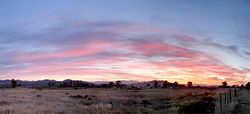Ashton, South Africa: Difference between revisions
Appearance
Tom.Reding (talk | contribs) m +{{Authority control}} (1 ID from Wikidata), WP:GenFixes on |
m Htonl moved page Ashton, Western Cape to Ashton, South Africa over redirect: per recent changes to naming conventions at WP:PLACEDAB |
(No difference)
| |
Revision as of 18:18, 2 January 2022
Ashton | |
|---|---|
 Sunset over Ashton | |
| Coordinates: 33°50′5″S 20°3′17″E / 33.83472°S 20.05472°E | |
| Country | South Africa |
| Province | Western Cape |
| District | Cape Winelands |
| Municipality | Langeberg |
| Area | |
• Total | 23.5 km2 (9.1 sq mi) |
| Population (2011)[1] | |
• Total | 13,325 |
| • Density | 570/km2 (1,500/sq mi) |
| Racial makeup (2011) | |
| • Black African | 40.9% |
| • Coloured | 53.4% |
| • Indian/Asian | 0.2% |
| • White | 5.0% |
| • Other | 0.4% |
| First languages (2011) | |
| • Afrikaans | 58.6% |
| • Xhosa | 35.7% |
| • English | 1.4% |
| • Sotho | 1.3% |
| • Other | 2.9% |
| Time zone | UTC+2 (SAST) |
| Postal code (street) | 6715 |
| PO box | 6715 |
| Area code | 023 |
Ashton is a small town in the Western Cape in South Africa. The town is at the foot of the Langeberg mountain range, 10 km southwest of Montagu and 19 km east-southeast of Robertson. It is situated in a valley known for production of wines and fruit.[citation needed]
Ashton is known for its two canning factories, which boost its tourism.[citation needed] Ashton is also home to various tourist attractions, including vineyards and steam locomotives.[citation needed]
History
It was established in 1897 on the Roodewal farm and attained municipal status in January 1956. The town was named after the first station-master.[2]
References
Wikimedia Commons has media related to Ashton, Western Cape.



